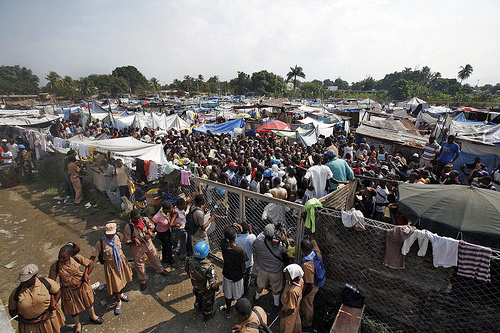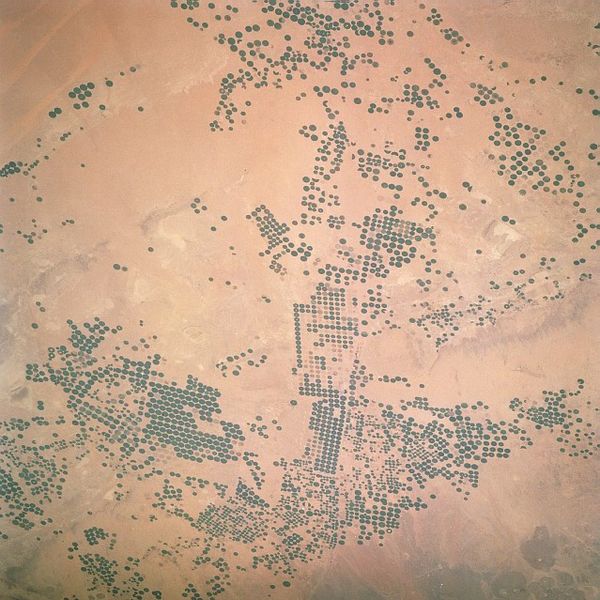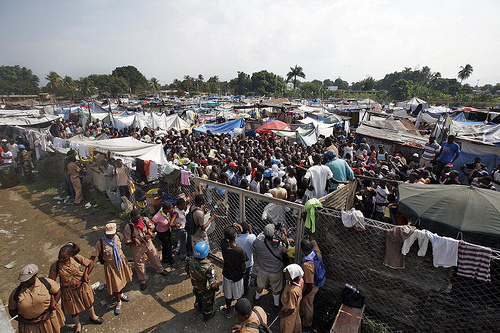 Haitians awaiting food distribution from a U.N. food program.Photo: U.N./Sophia ParisFor years — even decades — Earth Policy Institute president and Grist contributor Lester Brown has issued Cassandra-like warnings about the global food system. His argument goes something like this: Global grain demand keeps rising, pushed up by population growth and the switch to more meat-heavy diets; but grain production can only rise so much, constrained by limited water and other resources. So, a food crisis is inevitable.
Haitians awaiting food distribution from a U.N. food program.Photo: U.N./Sophia ParisFor years — even decades — Earth Policy Institute president and Grist contributor Lester Brown has issued Cassandra-like warnings about the global food system. His argument goes something like this: Global grain demand keeps rising, pushed up by population growth and the switch to more meat-heavy diets; but grain production can only rise so much, constrained by limited water and other resources. So, a food crisis is inevitable.
In recent years, two factors have added urgency to Brown’s warnings: 1) climate change has given rise to increasingly volatile weather, making crop failures more likely; and 2) the perverse desire to turn grain into car fuel has put yet more pressure on global grain supplies.
Brown’s central metaphor — which he’s been using at least since the mid-‘90s — will be familiar to readers who’ve lived through the previous decade’s dot-com and real-estate meltdowns: the bubble. The world has entered a “food bubble,” he argues; we’ve puffed up grain production by burning through unsustainable amounts of three finite resources: water, fossil fuels, and topsoil. At some point, he insists, the bubble has to burst.
Well, for the second time in three years, the globe is lurching toward a full-on, proper food crisis, especially in places like Haiti that have de-emphasized domestic farming and turned instead to the global commodity market for food. In 2008, global food prices spiked to all-time highs, and hunger riots erupted from Haiti to Morocco. Now prices are spiking again, and have already surpassed the 2008 peak, The Sydney Morning Herald reports.
As if on cue, Lester Brown has come out with another of his reports, this one titled (with that Brownianlight touch), World on the Edge: How to Prevent Environmental and Economic Collapse. You can download the whole thing free here, grab the brief presentation on food [PDF] lifted from the book, or just read Brown’s own post today for Grist on the topic.
Brown may sound at first blush like a neo-Malthusian predicting the inevitable collapse of human civilization, but he makes important points that I’ve never heard policymakers grapple with seriously.
Take the question of irrigation water. As I and others have pointed out before, India has essentially tapped dry the water table in its main agricultural regions since embracing industrial agriculture in the 1970s. Brown hastens to add that India, the globe’s second-most-populous nation, is hardly alone in facing an irrigation crisis. In China, he claims, 130 million people owe their sustenance to “grain produced by overpumping groundwater.”
Overall, Brown depicts a global food system characterized by severe fragility. With global grain reserves returning to the all-time lows reached in 2008, “the world is only one poor harvest away from chaos in world grain markets,” as he writes. Indeed, the main reason for the current upswing in prices, he states, is the heat wave that gripped Russia this past summer, which caused a 40 percent drop in that nation’s grain crop. Brown warns that a similar weather event in the U.S. corn belt (which produces several times more grain than Russian) would be calamitous — it would “likely result in unprecedented food price inflation and food riots in scores of countries, toppling weaker governments.”
Brown delivered his presentation on the food crisis at a teleconference Wednesday, and I listened in. After he finished, he opened the floor for questions, and I piped up. U.S. policy elites in both parties, when they can be bothered to comment on the global food situation, revert to biotech-industry talking points: In order to “feed the world,” we’ll need to convert as much food production as possible to patent-protected genetically modified seeds. What does he think of high-tech seeds’ chances of staving off the crisis? I asked.
Not much, he replied. Brown pointed out that that current-generation transgenic seeds have not increased yields; and that next-generation ones — like corn engineered to tolerate drought, or use nitrogen more efficiently — will likely increase yields “only marginally.” (The hype around nitrogen-efficient GMO technology is pretty overblown, as I showed last year.) Such technologies might have “important contributions to make,” Brown said, but will likely not be “nearly enough” to feed our growing population.
Coming from a man who’s been studying agricultural productivity since the 1960s, and who was in fact a booster of the original “Green Revolution” — the push by U.S. policymakers and foundations to prod farmers in the global south to use “modern” agriculture technologies such as hybrid seeds, industrial fertilizers and pesticides, and heavy irrigation — this is a significant statement.
Brown is no wild-eyed critic of the biotech industry. He is making a cold, informed assessment: its products are a distraction from, not a solution to, the task of averting a global food disaster. And if he’s right, our policymakers aren’t taking the problems he describes nearly seriously enough — and that’s chilling. (Here, for example, is USDA chief Tom Vilsack babbling about the wonders of biotech for feeding an expanding global population. Nina Fedoroff, Hillary Clinton’s chief science adviser, toes an even more rigid GMO-centric line. Then there’s the man in charge of directing USDA research, the GMO-fixated Roger Beachy.)
But there’s no reason to plunge into Malthusian anguish about a coming global food crash. A lot people across the world are thinking hard about how to grow sufficient food without sucking dry the global water supplies or burning through fossil fuels like there’s no tomorrow. For a bit of hope after imbibing a dose of Brown’s bitter truth, check out WorldWatch’s State of the World 2011 report, which surveys interesting sustainable-agriculture projects across the globe.



